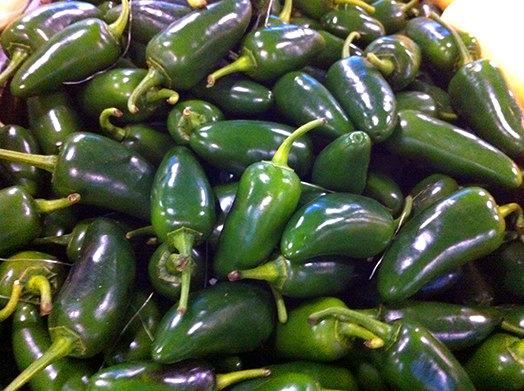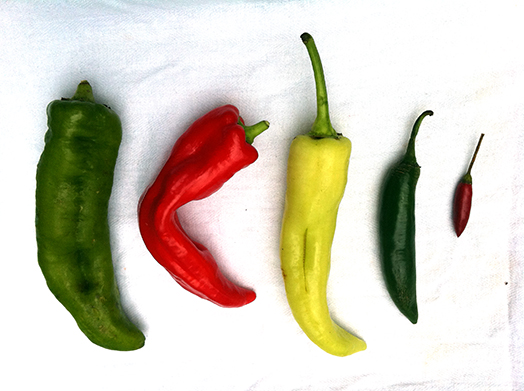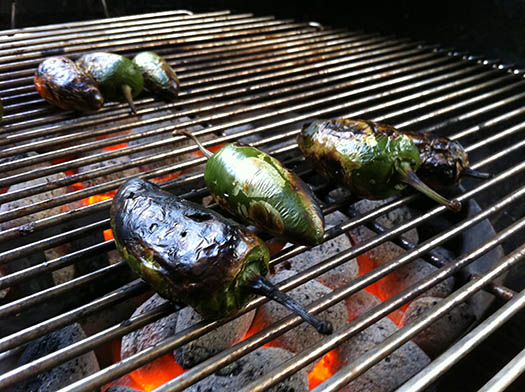I am going to have to call them chiles, sorry. I’m doing favourite, programme, colour etc the Oz way, but CHILLI, I can’t do.
I knew I was in trouble on arrival in Australia when the most common chile available in the grocery stores was just called “Green”. They’re all green! (at some point)
And here’s the rub: it’s very hard to find fresh chiles of the proper sort in Sydney. If there are some boutique growers or gardeners with some to spare, please shout out. The fresh chiles there are, pictured above, are not so great in Mexican food. The Bullhorn is the largest, fleshiest chile, but is quite sweet. The Yellow pepper is also a sweet pepper, and additionally isn’t suitable for roasting. The “green” chile and birdseye chiles that are commonly available are best in Asian dishes.
Intermittently you can find jalapeños, and this is going to be your staple chile (chilli) for cooking.
 As mentioned in the Doña salsa recipe, the heat in commonly-available jalapeños in Sydney varies quite radically. That’s fine, because when you find mild ones, these become your replacements for milder chiles such as Anaheim, New Mexico, and Poblano chiles. Flavor-wise – these mild jalapeños give a good chile flavor without adding a sweet taste or overpowering heat.
As mentioned in the Doña salsa recipe, the heat in commonly-available jalapeños in Sydney varies quite radically. That’s fine, because when you find mild ones, these become your replacements for milder chiles such as Anaheim, New Mexico, and Poblano chiles. Flavor-wise – these mild jalapeños give a good chile flavor without adding a sweet taste or overpowering heat.
In Texas jalapeños became a little passe for some folks and many became fans of the saucy little serrano. But I’m a jalapeño man. At least I am now.
Sourcing Jalapenos
Coles and Woolies sometimes have them in Sydney’s Inner West. I find the Woolworth’s by Town Square in the CBD almost always has them. Paddy’s Markets in Chinatown *sometimes* has them, (and sometimes habañeros if the gods are smiling). If I’m desperate I’ll drive out to Paddy’s Markets in Flemington and wander the aisles until someone has them. I’m preparing a Flemington post and I’ll try to make a map to guide you, because that place is HUGE.
I recently bought some chile seeds from http://www.fireworksfoods.com.au/ and am trying to grow my own. I missed Spring, but what the heck.
Preserving Jalapeños
Given the uncertain availability of these lil babies, I’ve taken to preserving them in a couple different ways so I can cook when they’re not in the shops.
1. Freezing
It actually works to toss a bunch of fresh jalapeños into a ziplock bag and drop them in the freezer. When thawed, they’ll be a little soggy, maybe not the best for a crisp fresh garnish or pico de gallo, but they’ll blend up fine into a salsa or stew.
2. Pickling
I miss savory dill pickles (common pickles in Sydney grocers are usually sweet) and have been learning how to pickle this last year. Here’s the ultimate pickling liquid: 1 cup vinegar, 6 cups water, 1/3 cup salt. (scale as necessary). When I pickle jalapeños I usually cut them into nacho slices and toss in some crinkle-cut carrot discs and a few cloves of garlic. I’ll post a recipe eventually. You’ll need to be up for water-bath canning.
3. Roasting, then freezing
This is the bomb. Roast the chiles on a grill or in a baking pan in the oven, then either a) immediately put them in a plastic bag and freeze them. b) remove the blistered skins and seeds and them freeze them c) remove the skins and seeds, puree them, and freeze them. I try to freeze them in very small plastic bags or containers, so I don’t have to unthaw a bunch of them just to use a couple.
The Missing Chiles
In August each year, Hatch, New Mexico inundates the southwestern United States with the most amazing green chiles in the world. These are called New Mexican chiles in the stores. These are about the same size, perhaps a little smaller and flatter, than the Bullhorn chiles available in Oz.
A similar chile is the Anaheim chile, which is often quite mild. I add these to stewing chickens, salsa verdes, or chili.
A tiny alternative to jalapenos is the Serrano, a dainty pepper that packs a wallop. Similar to the birdseye chilis in Oz, but green, and slightly less acidic.
Poblanos are larger and tougher, they become the hardy Ancho chile when dried.



